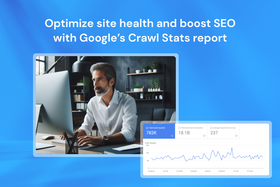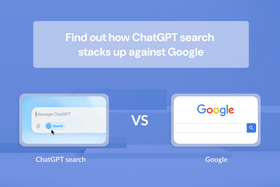What is generative engine optimization? A new era for SEO
Generative engine optimization helps AI search engines like ChatGPT and Gemini find, understand, and rank your content. Learn how to optimize your content to achieve better visibility in AI-generated results.
Updated August 19, 2025

Search is evolving quickly as AI changes how we get answers. According to a recent study, 82% of consumers find AI-powered search more helpful than traditional SERPs, and nearly half (49%) prefer chatbots like ChatGPT to search for information.
This shift affects how users find and interact with your content. Traditional SEO is still important, but no longer enough on its own. And that’s where generative engine optimization (GEO) comes in.
GEO helps ensure your content appears in AI Overviews and answers from AI-driven search engines. This new approach is reshaping the future of SEO and how businesses connect with their audiences.
In this blog, I’ll explain what GEO is, why it matters, and how it will impact your strategy moving forward.
Key takeaways
- GEO refers to the process of optimizing content to increase visibility and inclusion in AI-generated search results.
- Structuring content around real user questions and intent helps AI search engines identify your content as a relevant answer.
- A strong, consistent brand presence across platforms can help boost your visibility in AI-generated answers.
- Formatting your content with clear sections and concise answers makes it easier for AI to find and feature your content.
What is GEO?
Generative engine optimization is the process of optimizing your content to appear within responses generated by AI-driven search engines and large language models (LLMs) like ChatGPT, Gemini, Perplexity, and Copilot.
Instead of only focusing on rankings, the goal of GEO is to help AI tools understand, surface, and present your content to increase visibility and drive more qualified traffic.
Note: Google is already shifting to an AI-first search experience with AI Mode. Once they bring Gemini into search completely (as they said they will), the distinction between SEO and GEO might become obsolete, along with traditional SEO tactics.
» Discover the differences between ChatGPT search and Google.
Why is GEO important for your website?
GEO isn’t replacing SEO (at least not yet), but it’s quickly becoming essential for staying visible in a generative AI-driven world. Here’s why it matters and why brands are starting to rethink how they measure success:
- To stay present in evolving query types: AI tools are handling more than just informational, commercial, or transactional queries. Users now ask for help with problem-solving, comparisons, brainstorming, and complex tasks. GEO helps your content show up for these searches.
- To increase brand awareness: Optimizing for AI search tools gives your content a better chance of featuring directly in the responses, positioning your website as a trusted, authoritative source. This kind of exposure builds trust and brand recognition.
- To support conversions: AI Overviews and search tools now influence purchase decisions before users even visit your site. GEO helps your brand appear in those early touchpoints and bring high-intent users into your sales funnel, even if the impact is harder to measure.
- To gain a competitive edge: Early adopters of GEO are more likely to appear in AI-generated answers and can earn trust and visibility before competitors catch up. Plus, it becomes harder for others to displace you once your content is featured regularly.
- To future-proof your content: GEO encourages the creation of high-quality, AI-friendly content that’s built to be cited and surfaced. As traditional search shifts toward AI-driven discovery, this approach helps keep your site visible and relevant.
READ MORE: How AI Overviews affect B2B vs. B2C search performance
GEO vs. SEO: What's the difference?
Before Google introduced AI Mode, I would have drawn a much sharper line between SEO and GEO. But with search becoming more conversational—and Google doubling down on this direction—I believe the two will eventually merge.
That said, we’re not fully there yet. So, to better understand how GEO and SEO compare right now, here’s a quick side-by-side look at their differences.
| Aspect | GEO | SEO |
|---|---|---|
| Focus | Optimizing for AI platforms that generate direct answers and summaries | Optimizing for traditional search engines like Google to achieve high rankings and drive traffic |
| User interaction | Users receive a summarized answer directly from AI, reducing the need to click through to your website | Users click on a link to visit your website and find information |
| Content optimization | Prioritizes making content easily digestible and synthesizable by AI | Relies on keywords, backlinks, technical SEO, and on-page SEO |
| Performance metrics | Still evolving, but based on how often your website appears in AI-generated responses | Based on SEO KPIs like keyword rankings, clicks, impressions, bounce rate, etc. |
LEARN MORE: What zero-click searches mean for your SEO strategy
What still matters for both GEO and SEO
Some fundamentals remain crucial no matter which side of the fence you’re on:
- Crawlability and indexability: Your website needs to be crawled and indexed to appear in search. Certain LLMs don’t fully render JavaScript yet, so your content needs to appear directly in the HTML.
- Core Web Vitals: In traditional SEO, Google has used UX signals for ranking purposes. With LLMs, the impact is more indirect. Poor performance can reduce the chances of your content being included in AI-generated results, but on-page user satisfaction isn’t currently a direct signal (as far as we know).
- Structured data: Adding schema markup helps improve how search engines and AI understand your content. Not all LLMs use structured data now, but it remains a valuable asset that could gain importance.
- Original, expert, and fresh content: Your content must present facts clearly, avoid speculation, and include reliable sources. Though LLMs might not follow Google’s E-E-A-T requirements, they still value factual and verifiable content.
- Content in multiple formats: Repurposing content across formats—text, social media videos, audio, and images—boosts visibility in both GEO and SEO. LLMs can reference transcripts, visuals, and even translate content into other languages, which can increase your chances of being featured.
- Topical authority: Being cited by authoritative and trusted sources is still critical. For traditional search engines, we measure this through backlinks. For LLMs, we measure mentions, citations, and strong brand associations with specific topics or categories.
- Semantic relevance and clear structure: Bullet points, tables, short and clear sentences, summaries, FAQs, and NLP-friendly formatting all help. Deep, comprehensive topical coverage is important in both worlds.
» Learn more about the impact of AI on SEO.
What's new and unique to GEO?
Generative AI-driven search introduces fresh challenges that require different tactics:
- Personalization and context: AI personalizes results using a user’s full digital context. This includes emails, calendars, location, and search history. Because of this, two users who ask the same question may get very different answers based on their personal data.
- Expanded query scope: Google's AI Mode uses what they call the "query fan-out" technique. It breaks queries into many related subtopics and runs multiple searches at once. This means your content must cover a wide range of related queries and focus on user intent, not just exact keywords.
» Find out if there's a difference between GEO, AIO, and LLMO.
How do generative AI engines work?
Generative AI engines use complex techniques to analyze vast amounts of data and create answers that feel natural and relevant. While the details can be technical, understanding the general process can help you better align your content with how these LLMs operate.
Keep in mind: This space is evolving quickly. While we don’t have all the answers yet, current research and industry insights offer a useful picture of how these engines process and generate content.
SEE ALSO: Are llms.txt files the missing link in AI-powered SEO?
Here is how the process works:
- Data gathering: The AI collects information from a wide range of sources, including websites, databases, and other digital content. This large collection builds a comprehensive knowledge base that supports diverse queries.
- Data preparation: The AI cleans and organizes the data to improve quality. This involves removing duplicates, correcting errors, and standardizing formats to ensure consistency and reliability.
- Model training: Machine learning models train on the prepared data to recognize patterns and understand natural language. This training helps the AI interpret the meaning behind queries and grasp the context within the data.
- Fine-tuning: Developers adjust and refine the models to enhance their accuracy on specific topics or types of questions. Fine-tuning allows the AI to better handle queries and provide more precise answers.
- Answer generation: When a user submits a question, the AI pulls relevant information from its knowledge base. It then generates a clear and well-structured response that directly addresses the query.
- Quality review: Human reviewers evaluate the AI-generated answers for accuracy, clarity, and relevance. Their feedback helps improve the model’s future performance and ensures higher quality responses.
- Content prioritization: The AI prioritizes the most relevant, trustworthy, and up-to-date information when crafting answers. This ensures users receive responses that best address their needs.
» Compare Google Gemini vs. ChatGPT to find out which chatbot is better.
8 key GEO strategies and best practices
1. Strengthen your brand presence
To ensure your brand gets recognized by AI, use consistent messaging, visual identity, and value proposition across all platforms.
Try these steps to build brand awareness across channels:
- Keep your messaging clear and consistent across your website, social media, emails, and ads.
- Engage with your audience on multiple platforms to increase mentions and shares.
- Ask customers to leave reviews and testimonials to build trust and authority.
- Get brand mentions on authoritative sites.
- Collaborate with influencers or partners to expand your reach and credibility.
Expanding your marketing beyond SEO helps your brand get noticed by both people and search algorithms.
» Find out more about why branding matters.
2. Encourage clicks with in-depth resources
Even though generative AI provides quick answers, your site can still attract valuable traffic by offering deeper, more detailed information than AI summaries alone.
Give users a reason to click by creating:
- Interactive tools that engage and assist your audience.
- Comprehensive guides or tutorials that cover complex subjects thoroughly.
- Downloadable templates or resources tailored to user needs.
3. Offer a good site experience
Getting featured in an AI-generated answer is only part of the equation. What users experience after they click plays a big role in whether your content is trusted and explored further.
To deliver a good site experience:
- Optimize for mobile devices and fast loading speeds to reduce friction.
- Design for clarity, with clean layouts and minimal distractions.
- Include clear calls to action that guide users based on their intent.
Remember: Users should easily find and engage with your content. Their next action should be effortless, whether it's downloading a resource, signing up, or exploring related topics.
4. Present information in an AI-friendly format
Both AI and users prefer content that’s quick to scan and easy to understand. Organizing your content with a clear structure helps AI identify key information and improves user experience.
To format effectively:
- Break content into digestible sections or lists.
- Use clear headings for easy navigation.
- Begin sections with straightforward answers.
- Include FAQs or pros and cons to address common questions or concerns.
5. Strengthen trust signals (E-E-A-T)
Generative AI often highlights content from brands that users and algorithms already trust. This trust is built through reputation, reviews, consistent messaging, and visibility on authoritative third-party websites.
To increase trust:
- Publish content created or reviewed by recognized experts in your field.
- Monitor and respond to feedback to demonstrate accountability and care.
- Ensure authorship transparency and subject-matter expertise.
- Maintain consistent branding and tone.
These signals help search engines link your brand to specific topics and audiences. This makes it easier for your content to be pulled into AI summaries and answers.
6. Go beyond keywords
Instead of chasing individual keywords, focus on comprehensively covering your chosen topics.
To build topical authority:
- Understand your users' intent at every stage of their journey and anticipate what they'll want to know next.
- Include detailed and related questions aligned with current search behavior.
- Signal to search engines that your site is a trusted source by covering topics comprehensively and logically.
- Use internal linking strategically to guide both users and search engines through your content. This reinforces your authority within your niche.
» Build authority and share value by creating authentic, expert content.
7. Remove outdated content from your site
Maintaining topical depth also involves removing what no longer serves your goals.
To refine your site's content:
- Conduct a content audit periodically to identify pages or resources that no longer align with your current brand or audience interests.
- Eliminate duplicate content that provides no unique value and may hurt SEO rankings.
This process improves overall content quality signals, sharpens your topical focus, and reduces "noise" for search engines assessing your expertise.
8. Expand into emerging markets
As generative AI tools like Gemini and ChatGPT roll out, they often launch first in English-speaking markets. If your business operates globally, expanding your GEO efforts into emerging or non-English markets can be advantageous.
To successfully expand into emerging markets:
- Adapt your messaging and content to the local language, culture, and search behaviors.
- Leverage local platforms and channels to reach your audience where they spend time.
- Test and refine your approach based on local performance data.
GEO is the future of search
SEO isn't disappearing, but how we show up in search is changing fast. With AI search engines becoming more prevalent, GEO is becoming just as important as traditional SEO.
It's no longer just about ranking in the traditional SERP; it's also about being surfaced, cited, and trusted by AI. Clear structure, topical depth, citation-worthy content, and strong brand signals are what matter now. Search is changing, and your strategy should too.
» Chat with us about how to optimize your strategy for AI-powered search.
Frequently asked questions
What is GEO?
GEO is the process of optimizing your content so AI search tools and LLMs can easily understand and include it in their answers.
What is the difference between GEO and SEO?
SEO focuses on optimizing for traditional search engines like Google. GEO targets AI search engines that generate synthesized responses to specific queries.
Is GEO replacing SEO?
Not entirely—GEO is emerging alongside SEO as AI search grows. Both approaches are valuable and often work best together.





